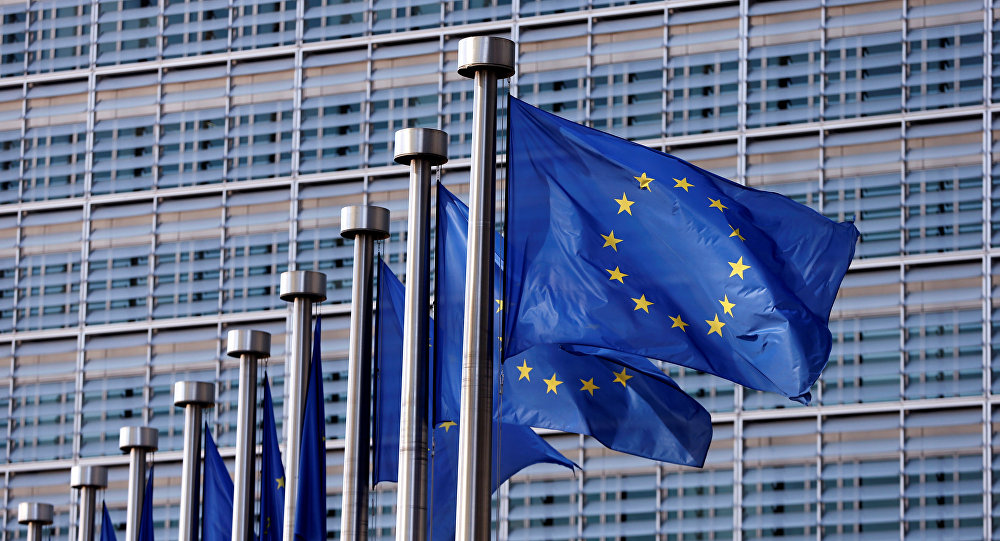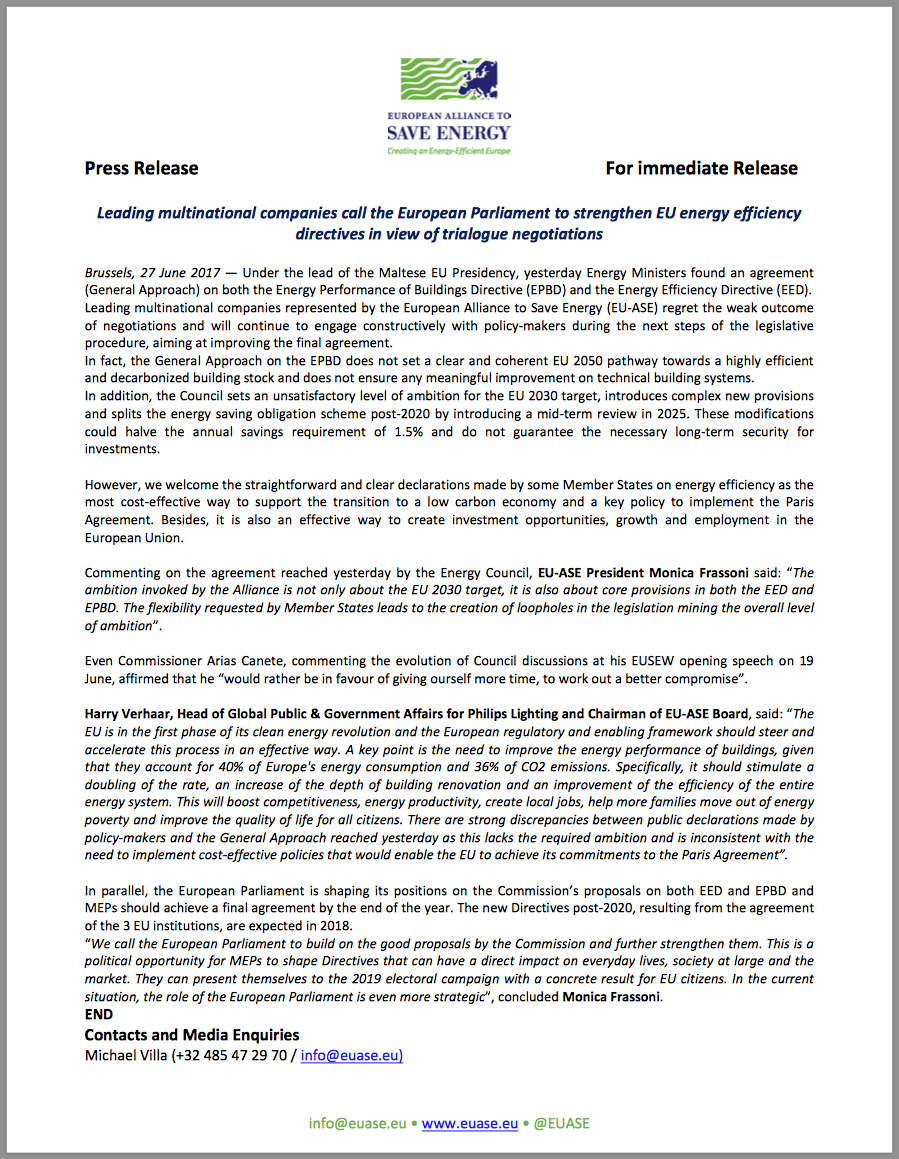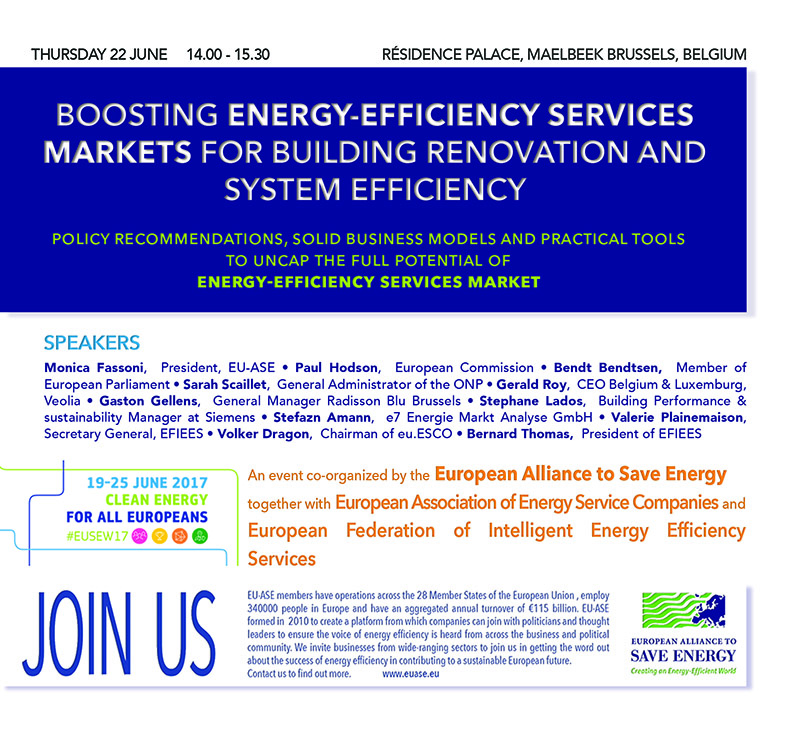EU under fire over ‘weak outcome’ of new energy directives

The European Union has come under fire over what has been labelled a “weak outcome” after energy ministers rubber stamped new EU energy efficiency directives.
Earlier this week European Union ministers reached an agreement on new targets to be established within both the Energy Performance of Buildings Directive and the Energy Efficiency Directive.
Having initially set out to establish a binding 30% energy efficiency target, the EU eventually agreed to set the desired efficiency rate at 30% but make it non-binding. A number of member states argued the target should be lowered to 27%, however these calls were resisted.
Read the full article here: https://www.cleanenergynews.co.uk/news/efficiency/eu-under-fire-over-weak-outcome-of-new-energy-directives
European Alliance to Save Energy views on the draft ITRE Report on the Energy Performance of Building Directive (EPBD) the European Alliance to Save Energy (EU-ASE) welcomes Mr Bendtsen MEP’s draft report on the EPBD revision
Dear Members,
Re: European Alliance to Save Energy views on the draft ITRE Report on the Energy Performance of Building Directive (EPBD) the European Alliance to Save Energy (EU-ASE) welcomes Mr Bendtsen MEP’s draft report on the EPBD revision which sets a very good basis for the EPBD to support the reduction of energy consumption of the existing building stock, in line with the Efficiency First principle. We fully endorse the rapporteur’s view that “an ambitious and future-proof Directive for the Energy Performance of Buildings is (…) needed to secure a highly energy efficient and decarbonised European building stock.”
EU-ASE regrets that yesterday the Energy Council has reached a General Approach on a very weak EPBD text which waters down the Commission’s proposal. The General Approach has weakened many provisions which do not set a clear and coherent EU 2050 pathway towards a highly efficient and decarbonized building stock and do not ensure any meaningful improvement on technical building systems.
In this perspective, EU-ASE is ready to offer support to all ITRE Committee Members to further improve and strengthen some articles to get an ambitious revision of the EPBD and make it a true success for citizens, businesses and investors.
EU-ASE has identified 3 main areas where the draft report should be enhanced:
• The EPBD must be aligned and coherent with a cost-effective EU energy efficiency target: the EPBD should head towards achieving an overall binding 40% energy efficiency target. This level of ambition, already supported by the European Parliament, is pivotal for the EU to deliver on the Paris Agreement and ensure the expected savings alongside health, energy security and jobs benefits. This ambition is based on in-depth evaluation of the aggregated savings potentials in key sectors, notably buildings and transport, and is entirely feasible under current market conditions with existing technologies.
• Further strengthening of ambitious national long-term renovation strategies: we welcome the rapporteur’s approach to link and clarify the contribution of these strategies to the achievement of the EU 2030 target for energy efficiency. In this sense, EU-ASE fully endorses the requirement to Member States to shape comprehensive and ambitious building renovation strategies, and to make clear their contribution to the achievement of the EED target.
We encourage ITRE members to support and consolidate these strategies:
– The objective should now be on reinforcing the national renovation strategies with a focus on worst performing buildings, the addition of trigger points, a new milestone set at 2040 and the clarification that the 2050 final goal is to ensure a highly energy efficient and decarbonised building stock (in line with the correct implementation of the Efficiency First principle).
– Member States should be encouraged to plan their renovation strategies in terms of district and entire energy systems to reap the full potential of high-efficiency energy demand and supply solutions and achieve energy efficiency gains throughout the entire energy chain. By doing so, renovation strategies will also achieve synergies in terms of possible use of waste heat, and integrations of various parts of energy systems (heat, electricity, buildings and transport) adding to potential energy gains.
– Further strengthening is necessary to ensure that the long-term renovation strategies lead to concrete actions. The national strategies must have a differentiated approach and targets for buildings categories to consider cost-competitiveness and streamline the mobilization of financing. They should also make room for energy performance services and contracts that can contribute towards significant energy savings with little to no capex in short periods of time.
– Building Renovation Passports should be fostered as tools to accelerate and support ambitious, coordinated step-by-step building renovation.
• Optimising Technical Building Systems: the report is missing meaningful improvements for provisions related to technical building systems, that would fully embrace the cost-effective potential for energy management at building level through building automation, control, monitoring, management systems and built-in lighting. Notably, strengthened articles 8.5, 8.6, Article 14 and Article 15 are critical to ensure appropriate adjustment and control of technical building systems. In order to accelerate renovation and enable buildings’ connectivity to the energy system, key functionalities shall be prescribed in non-residential buildings over 250 MWh/a and in residential buildings with central technical building system of over 100kw power. Additionally, appropriate control functionalities in individual rooms are needed in particular in those residential buildings.
Further details on our positions concerning both the Energy Efficiency Directive (EED) and the Energy Performance of Buildings Directive (EPBD) are included in the Position Papers enclosed to this letter.
Leading multinational companies call the European Parliament to strengthen EU energy efficiency directives in view of trialogue negotiations

Brussels, 27 June 2017 — Under the lead of the Maltese EU Presidency, yesterday Energy Ministers found an agreement (General Approach) on both the Energy Performance of Buildings Directive (EPBD) and the Energy Efficiency Directive (EED).
Leading multinational companies represented by the European Alliance to Save Energy (EU-ASE) regret the weak outcome of negotiations and will continue to engage constructively with policy-makers during the next steps of the legislative procedure, aiming at improving the final agreement.
In fact, the General Approach on the EPBD does not set a clear and coherent EU 2050 pathway towards a highly efficient and decarbonized building stock and does not ensure any meaningful improvement on technical building systems.
In addition, the Council sets an unsatisfactory level of ambition for the EU 2030 target, introduces complex new provisions and splits the energy saving obligation scheme post-2020 by introducing a mid-term review in 2025. These modifications could halve the annual savings requirement of 1.5% and do not guarantee the necessary long-term security for investments.
However, we welcome the straightforward and clear declarations made by some Member States on energy efficiency as the most cost-effective way to support the transition to a low carbon economy and a key policy to implement the Paris Agreement. Besides, it is also an effective way to create investment opportunities, growth and employment in the European Union.
Commenting on the agreement reached yesterday by the Energy Council, EU-ASE President Monica Frassoni said: “The ambition invoked by the Alliance is not only about the EU 2030 target, it is also about core provisions in both the EED and EPBD. The flexibility requested by Member States leads to the creation of loopholes in the legislation mining the overall level of ambition”.
Even Commissioner Arias Canete, commenting the evolution of Council discussions at his EUSEW opening speech on 19 June, affirmed that he “would rather be in favour of giving ourself more time, to work out a better compromise”.
Harry Verhaar, Head of Global Public & Government Affairs for Philips Lighting and Chairman of EU-ASE Board, said: “The EU is in the first phase of its clean energy revolution and the European regulatory and enabling framework should steer and accelerate this process in an effective way. A key point is the need to improve the energy performance of buildings, given that they account for 40% of Europe’s energy consumption and 36% of CO2 emissions. Specifically, it should stimulate a doubling of the rate, an increase of the depth of building renovation and an improvement of the efficiency of the entire energy system. This will boost competitiveness, energy productivity, create local jobs, help more families move out of energy poverty and improve the quality of life for all citizens. There are strong discrepancies between public declarations made by policy-makers and the General Approach reached yesterday as this lacks the required ambition and is inconsistent with the need to implement cost-effective policies that would enable the EU to achieve its commitments to the Paris Agreement”.
In parallel, the European Parliament is shaping its positions on the Commission’s proposals on both EED and EPBD and MEPs should achieve a final agreement by the end of the year. The new Directives post-2020, resulting from the agreement of the 3 EU institutions, are expected in 2018.
“We call the European Parliament to build on the good proposals by the Commission and further strengthen them. This is a political opportunity for MEPs to shape Directives that can have a direct impact on everyday lives, society at large and the market. They can present themselves to the 2019 electoral campaign with a concrete result for EU citizens. In the current situation, the role of the European Parliament is even more strategic”, concluded Monica Frassoni.
Boosting energy-efficiency services markets for building renovation and system efficiency

The event promoted policy recommendations, solid business models and practical tools to uncap the full potential of energy-efficiency services market.
High-level speakers from the EU and international institutions discussed the legislative framework and market conditions for energy-efficiency services, including the current situation and policy outlook for the 2020 & 2030 horizons and beyond.
In particular, the event highlighted the cost-effective contribution of the current provision for the promotion of energy-efficiency services in art. 18 of the Energy Efficiency Directive to the achievement of the national ‘long-term renovation strategies’ proposed in art. 2a of the revised Energy Performance of Buildings Directive.
During the event, a number of practical examples were presented, showing how energy efficiency service solutions, such as energy performance contracts, can be successfully deployed in order to deliver a high degree of energy savings along with further results in terms of innovation and cost-efficiency. The presentations were given on a peer-to-peer basis by the clients and providers involved in the projects displayed.
The event was followed by the presentation of two practical tools for boosting the energy-efficiency services market elaborated within EU-funded projects: the European Code of Conduct for Energy Performance Contracting (EPC) and Quality Criteria for EPC.
The European Code of Conduct for EPC, established as part of the Transparense project in 2014, defines the basic values and principles that are considered fundamental for the successful preparation and implementation of EPC projects. It was developed in tight collaboration between actors of the European EPC sector: providers, clients and European associations representing energy services companies (ESCOs). Since it was released, it has been a reference document in the field of EPC and the number of its signatories still keeps growing.
Quality Criteria (technical and financial) for EPC are a new tool that will be developed within the QualitEE project, starting in mid-2017 under the H2020 programme. QualitEE aims at scaling up investment in energy-efficiency services by reducing complexity of such services and increasing the trust of clients and financial institutions in energy-efficiency service providers. Technical and financial Quality Criteria will therefore be developed to bring more clarity in Energy Performance Contracts, facilitating certification of energy efficiency services, thus fostering investment in this sector. QualitEE is going to complement the Energy Efficiency Financial Institutions Working Group (EEFIG) held by the European Commission.
The closing remarks by market practitioners provided another brief overview of the role of EPCs, their potential and existing barriers to their further development, as well as possible ways and ideas to tackle them.
The event brought together the main actors of energy-efficiency service market: policy makers; providers of energy-efficiency services (ESCOs), public and private clients: municipalities, industrial, commercial and residential sectors; technology providers, financial institutions, academia and other relevant actors interested in boosting the market.
